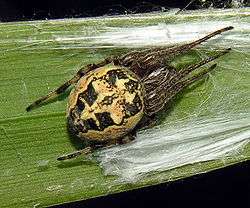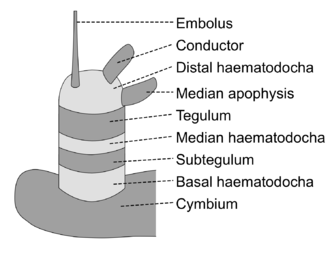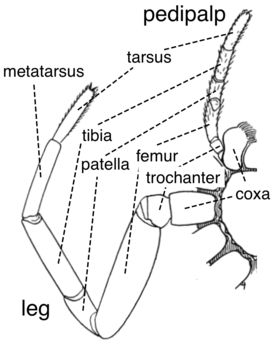Glossary of spider terms
This glossary describes the terms used in formal descriptions of spiders; where applicable these terms are used in describing other arachnids.
Terms
A

Abdomen or opisthosoma: One of the two main body parts (tagmata), located towards the posterior end; see also Abdomen: Other animals
Anal tubercle: A small protuberance (tubercule) above the spinnerets through which the anus opens[1]
Apophysis (plural apophyses): An outgrowth or process changing the general shape of a body part, particularly the appendages; often used in describing the male pedipalp[1]
Atrium (plural atria): An internal chamber at the entrance to the copulation duct in female haplogyne spiders[1]
B
Bidentate: Having two teeth
Book lungs: Respiratory organs on the ventral side (underside) of the abdomen, in front of the epigastric furrow, opening through narrow slits;[2] see also Book lungs
Bulbus → palpal bulb
C
Calamistrum (plural calamistra): Modified setae (bristles) on the metatarsus of the fourth leg of spiders with a cribellum, arranged in one or more rows or in an oval shape, used to comb silk produced by the cribellum; see also Calamistrum
Caput (plural capita): → cephalic region
Carapace: A hardened plate (sclerite) covering the upper (dorsal) portion of the cephalothorax;[2] see also Carapace
Carpoblem: The principal tibial apophysis on the male pedipalp; also just called the tibial apophysis
Cephalic region: The front part of the cephalothorax, separated from the thoracic region by the cervical groove[3]
Cephalothorax or prosoma: One of the two main body parts (tagmata), located towards the anterior end, composed of the head (cephalic region or caput) and the thorax (thoracic region), the two regions being separated by the cervical groove; covered by the carapace and bearing the eyes, legs, pedipalps and mouthparts[2]
Cervical groove: A shallow U-shaped groove, separating the cephalic and thoracic regions of the carapace[2]
Chelicera (plural chelicerae): One of two appendages at the front of the carapace, made up of basal portion, the paturon, and the fang;[4] sometimes called the jaw; see also Chelicerae
Cheliceral furrow: A shallow groove on the basal portion of a chelicera accommodating the fang, usually having teeth on its margins[5]
Claw → tarsal claw
Claw tuft: A dense group of hairs or bristles (setae) underneath the paired tarsal claws, usually well developed in hunting spiders[5]
Clypeus: The area of the carapace between the anterior (frontmost) eyes and the anterior edge of the carapace[5]
Colulus: A short protuberance in the middle of the underside of the abdomen in front of the spinnerets, considered to be a modification of the cribellum[5]
Conductor → palpal bulb
Copulatory opening: An opening in the ventral abdomen of female spiders; in entelegyne spiders, a double opening in the epigyne through which the embolus is inserted; in haplogyne spiders, a single opening through which male palpal bulb is inserted[5]
Coxa → segments
Cribellum: A sieve-like plate in front of the spinnerets, used in conjunction with the calamistrum; spiders with a cribellum are called cribellate, those without ecribellate;[3] see also Cribellum
Cymbium (plural cymbia): The end part of the tarsus of the pedipalp in a mature male, usually hollowed out and bearing the palpal bulb[5]
D
Dionychous: With two claws on the tarsus of each leg;[5] a feature of spiders in the clade Dionycha
Dorsal groove → fovea
Dorsum: The upper (dorsal) portion or surface of the body or abdomen; → ventrum
E
Ecribellate → cribellum
Embolus → palpal bulb
Endite → maxilla
Entelegyne: A spider whose female has an epigyne and separate ducts leading to spermathecae for sperm storage and to the uterus for fertilization,[5] creating a "flow-through" system; → haplogyne
Epigastric furrow: A transverse slit towards the front (anterior) of underside of the abdomen; the front pair of book lungs open at the edge of this furrow as do the genital openings (gonopores)[6]
Epigyne or epigynum (plural epigynes): A hardened plate on the underside of the female abdomen in which the copulatory openings are located; only fully developed in mature females of entelegyne spiders;[5] see also Epigyne
F
Fang: The final hinged part of the chelicera, normally folded down into a groove in the basal part of the chelicera; venom is injected via an opening near the tip of the fang[7]
Femur → segments
Fertilization duct: A duct in female entelegyne spiders leading from the spermathecae to the uterus[6]

Folium: A broad leaf-like marking along the medial line of the top of the abdomen
Fovea (also called thoracic furrow or dorsal groove): A depression or pit in the centre of the carapace of a spider marking an inward projection of the exoskeleton to which stomach muscles are attached[8][9]
G
Gnathocoxa → maxilla
Gonopore: The genital opening; located in the epigastric furrow; see also Gonopore
H
Haematodocha → palpal bulb
Haplogyne: A spider whose female lacks an epigyne and in which the same ducts are used to transport sperm to the uterus and to the spermathecae;[10] → entelegyne
Heart mark: A narrow marking along the top of the abdomen roughly corresponding to the location of the heart
L
Labio-sternum mound: A mound separating the labium from the sternum, found in found in some tarantulas, where it can be a diagnostic feature[11]
Labium (plural labia): A hardened plate (sclerite) between the maxillae at the front of the sternum;[6] see also Arthropod mouthparts: Labium
Labrum (plural labra): A component (the "upper lip") of the mouthparts, concealed by the chelicerae;[6] see also Arthropod mouthparts: Labrum
Lateral (applied to appendages): Viewed from above or below, the sides of the leg or pedipalp, i.e. the surfaces parallel to the line of sight; → prolateral, retrolateral
M
Main eye: one of the two anterior median eyes (AME) that have the light-detecting units (rhabdomeres) pointing towards the source; particularly enlarged in the families Salticidae and Thomisidae;[12] → secondary eye
Maxilla (also called endite or gnathocoxa): Modified coxa of the pedipalp, used in feeding;[9][5] not the structure called by this name in other arthropods, for which see Maxilla (arthropod mouthpart)
Metatarsus → segments
O
Opisthosoma → abdomen
P
Palp → pedipalp

Palpal bulb (also called bulbus, palpal organ, genital bulb): The copulatory organ of the male spider, carried on the modified last segment of the pedipalp, used to transfer sperm to the female;[14] see also Palpal bulb
- Conductor: A part of the palpal bulb that accompanies and supports the embolus[5]
- Embolus: The final part of the palpal bulb containing the end of the sperm duct, usually thin, sharp-tipped and strongly hardened (sclerotized)[5]
- Haematodocha (plural haematodochae): A membranous, inflatable part of the palpal bulb[6]
- Subtegulum: A hardened part of the palpal bulb nearer its base than the tegulum
- Tegulum: The main hardened part of the palpal bulb
Paracymbium: An outgrowth of the cymbium on the male pedipalp[15]
Patella → segments
Paturon: The basal segment of a chelicera to which the fang connects[16]
Pedicel: The narrow connection between the cephalothorax and abdomen[16]
Pedipalp (plural pedipalps or pedipalpi; also called just palp): The second appendage of the cephalothorax in front of the first leg; bears the palpal bulb in male spiders;[6] → segments
Plumose setae are hairs having outgrowths or appendages on two sides, giving a feather-like appearance; the appendages vary in number, size and arrangement[17]
Pluridentate: Having multiple teeth
Procurved: Used to describe a structure which is curved in such a way that the outer edges are in front of the central part;[16] opposite recurved
Prolateral: Viewed from above or below, the side of a leg or pedipalp nearest the mouth, i.e. the side facing forward
Prosoma → cephalothorax
R
Rastellum (plural rastella): An often rake-like structure at end of the chelicera in mygalomorph spiders; used in burrowing[16]
Receptaculum (plural receptacula) → spermatheca
Recurved: used to describe a structure which is curved in such a way that the outer edges are behind the central part;[16] opposite procurved
Retrolateral: Viewed from above or below, the side of a leg or pedipalp furthest from the mouth, i.e. the side facing backwards
Retrolateral tibial apophysis: A backward-facing projection on the tibia of the male pedipalp
S
Scopula (plural scopulae): A brush of hairs (setae); called a claw tuft when on the end of the foot, where it improves adhesion[16][18]
Scutum (plural scuta): A hardened (sclerotized) plate on the abdomen of some spiders
Secondary eye: An eye belonging to the three pairs – anterior lateral eyes (ALE), posterior median eyes (PME) and posterior lateral eyes (PLE) – that are primarily movement detectors and have the light-detecting units (rhabdomeres) pointing away from the source;[19] → main eye

Segments or articles of the legs and pedipalps:
- Coxa (plural coxae): First leg segment, between body and trochanter; the coxa of the pedipalp is heavily modified to form the maxilla or endite
- Trochanter: Second leg segment, between coxa and femur
- Femur (plural femora): Third leg segment, between trochanter and tibia
- Patella (plural patellae): Fourth leg segment, between femur and tibia
- Tibia (plural tibiae): Fifth leg segment, between patella and metatarsus
- Metatarsus (plural metatarsi; also called basitarsus): Sixth leg segment, between tibia and tarsus; absent in the pedipalp
- Tarsus (plural tarsi; also called telotarsus): Seventh (last) leg segment, after the metatarsus
Seta (plural setae): A bristle;[16] spiders have a variety of hair-like structures of increasing size that are referred to as hairs, bristles (setae) or spines[20]
Sigillum (plural sigilla): A circular indentation on the outside of the spider, showing where an internal muscle is attached;[21] particularly on the sternum in some Mygalomorphae and on the dorsum in some Araneomorphae[16]
Sperm duct: A duct in the male palpal bulb used to store sperm[16]
Spermatheca (plural spermathecae; also called receptulacum, receptulacum seminis): A structure in the abdomen of female spiders used to store sperm after insemination and before fertilization;[16] see also Spermatheca
Spigot: A small pointed or cylindrical structure at the tip of a spinneret from which silk emerges[16]
Spine: A pointed, rigid structure on body and legs, usually with a basal joint;[22] spiders have a variety of hair-like structures of increasing size that are referred to as hairs, bristles (setae) or spines[20]
Spinneret: An appendage borne on the abdomen, typically one of six arranged in three pairs, anterior, median and posterior; silk emerges from small spigots on the spinnerets;[22] see also Spinneret
Sternum: The lower (ventral) portion of the cephalothorax
Stridulating organ: A series of thin ridges on a hardened part of the body; rubbing this with a matching series of short, stiff bristles (setae) elsewhere on the body creates a sound[22]
Subtegulum → palpal bulb
T
Tapetum (plural tapeta): A light-reflecting layer in a secondary eye making the eye appear pale[22]
Tarsal claw (claw): One of a set of claws at the tip of the tarsus; there may be a single pair, often concealed in a claw tuft, or an additional third central claw, much smaller than the other two[22]
Tarsus → segments
Tegulum → palpal bulb
Thoracic furrow → fovea
Tibia → segments
Trichobothrium (plural trichobothria): A slender hair-like structure of variable length on the legs and pedipalps, arising from a special socket; used to detect air movements, including sounds;[23] → seta, spine
Trochanter → segments
U
Unidentate: Having a single tooth
V
Venter (or ventrum): The lower (ventral) portion or surface of the body or abdomen; → dorsum
Abbreviations
Some abbreviations commonly found in descriptions of spider anatomy include:
- ALE: anterior lateral eyes
- ALS: anterior lateral spinnerets
- AME: anterior median eyes
- DTA: dorsal tegular apophysis
- DTiA: dorsal tibial apophysis
- LTA: lateral tegular apophysis
- MOQ: median ocular quadrangle
- PLE: posterior lateral eyes
- PLS: posterior lateral spinnerets
- PME: posterior median eyes
- PMS: posterior median spinnerets
- RCF: retrolateral cymbial fold
- RTA: retrolateral tibial apophysis
- VTA: ventral tegular apophysis
- VTiA: ventral tibial apophysis
See also
References
- 1 2 3 Saaristo (2010), p. 13.
- 1 2 3 4 Saaristo (2010), p. 14.
- 1 2 Saaristo (2010), pp. 14–15.
- ↑ Saaristo (2010), pp. 15, 18.
- 1 2 3 4 5 6 7 8 9 10 11 12 Saaristo (2010), p. 15.
- 1 2 3 4 5 6 Saaristo (2010), p. 17.
- ↑ Foelix (2011), p. 21.
- ↑ Roberts (1995), pp. 13–14.
- 1 2 Foelix (2011), pp. 17–18.
- ↑ Saaristo (2010), p. 16.
- ↑ Smith (1990).
- ↑ Foelix (2011), pp. 102–103.
- ↑ Coddington, J.A. (1990). "Ontogeny and homology in the male palpus of orb-weaving spiders and their relatives, with comments on phylogeny (Araneoclada: Araneoidea, Deinopoidea)". Smithsonian Contributions to Zoology. 496: 1–52. Figs 5–8
- ↑ Foelix (2011), pp. 226–227.
- ↑ Saaristo (2010), pp. 18–19.
- 1 2 3 4 5 6 7 8 9 10 11 Saaristo (2010), p. 18.
- ↑ Zakharov, Boris & Ovtsharenko, Vladimir (2015), "The covering setae of ground spiders (Araneae: Gnaphosidae)" (PDF), Arachnologische Mitteilungen 49, 49: 34–46, retrieved 2017-09-28
- ↑ Foelix (2011), p. 27.
- ↑ Foelix (2011), pp. 103–104.
- 1 2 Foelix (2011), pp. 84–101.
- ↑ Foelix (2011), pp. 41, 43.
- 1 2 3 4 5 Saaristo (2010), p. 19.
- ↑ Foelix (2011), pp. 89–92.
Bibliography
- Foelix, Rainer F. (2011). Biology of Spiders (3rd p/b ed.). Oxford University Press. ISBN 978-0-19-973482-5.
- Comstock, John Henry (1920) [First published 1912]. The Spider Book. Doubleday, Page & Company.
- Roberts, Michael J. (1995). Spiders of Britain & Northern Europe. London: HarperCollins. ISBN 978-0-00-219981-0.
- Saaristo, M.I. (2010). "Araneae". In Gerlach, J. & Marusik, Y. Arachnida and Myriapoda of the Seychelles Islands. Manchester, UK: Siri Scientific Press. pp. 8–306. ISBN 978-0-9558636-8-4.
- Smith, A.M. (1990). Baboon spiders: Tarantulas of Africa and the Middle East. London: Fitzgerald Publishing.